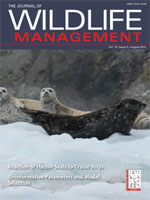Dispersal and philopatry may be influenced by habitat, intraspecific and interspecific interactions, and resource quality. Dispersal may vary substantially between urban and rural wildlife populations due to differences in urban–rural habitat and trophic relationships. We examined effects of environmental, body condition, and social influences on dispersal and philopatry of urban and rural red foxes (Vulpes vulpes) in east-central Illinois and western Indiana, USA. We recorded 96 dispersal events and 66 cases of philopatry in juvenile foxes. We used Akaike's Information Criterion to evaluate regression models of dispersal probability, initiation date, distance, and days spent dispersing. Habitat (i.e., urban–rural), sex, row-crop percentage in natal home ranges, family home-range overlap, and social interactions with family members all influenced dispersal probability. Juvenile foxes with fewer row crops in their home ranges, individuals with high intra-familial overlap of summer range, females, and urban foxes were associated with philopatry. Dispersals began mid-September and ended in March. Rural juveniles dispersed 23 days earlier than did urban conspecifics. Heavier foxes (capture wt) and those with heavily row-cropped home ranges dispersed earlier. Littermates dispersed at similar times, although in different directions. Dispersal distances averaged 44.8 km for all foxes (range = 1–478 km). Male and urban foxes dispersed farther than female and rural foxes, respectively. Time between dispersal and settlement averaged 41.2 days (range = 2–114 days), with urban foxes dispersing over longer time periods. Dispersal direction between the sexes had different directional distributions, though mean vectors for both were oriented north. Dispersing foxes selected cropland in proportion to availability, whereas grassland was selected preferentially. We demonstrate influences of habitat, resource availability, familial social interactions, and interspecific interactions on dispersal and philopatry of juvenile red foxes in an intensively row-cropped region of the Midwest. Our findings demonstrate red fox dispersal ecology differences in urban and rural environments. In intensively row-cropped regions of the Midwest where landscape crop harvest alters dispersal timing, minimizing seasonal habitat changes with permanent vegetative structure (e.g., crop food plots, native grass fields) would likely delay dispersal activity, and increase survival.
How to translate text using browser tools
1 August 2010
Natal Dispersal and Philopatry of Red Foxes in Urban and Agricultural Areas of Illinois
Todd E. Gosselink,
Kimberly A. Piccolo,
Timothy R. van Deelen,
Richard E. Warner,
Phil C. Mankin
ACCESS THE FULL ARTICLE
It is not available for individual sale.
This article is only available to subscribers.
It is not available for individual sale.
It is not available for individual sale.

Journal of Wildlife Management
Vol. 74 • No. 6
August 2010
Vol. 74 • No. 6
August 2010
Illinois
natal dispersal
philopatry
red fox
urban wildlife
Vulpes vulpes




